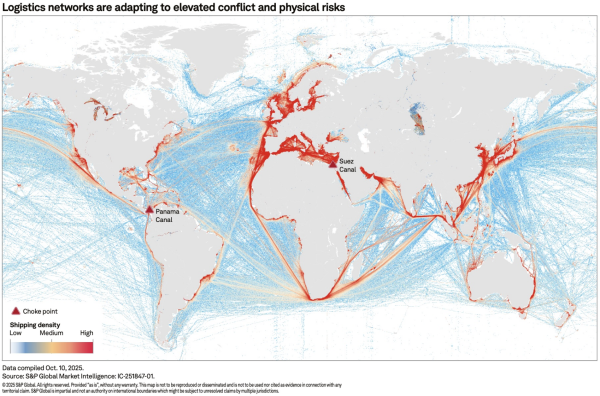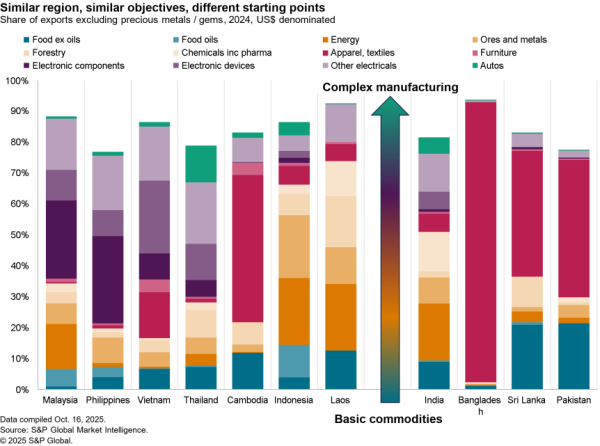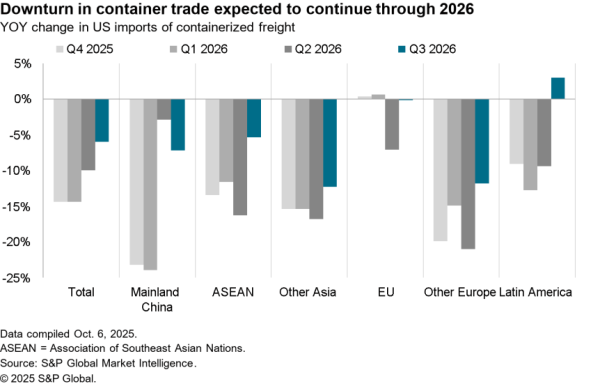Panjiva Research has published extensively since the U.S. general elections about the prospects for trade policy in the early part of the Biden administration. This report summarizes the key issues ahead, expected outcomes and data points to watch.
Senate, TPA and willingness – Getting deals done
The issue: President-elect Biden’s ability to deliver trade policy depends critically on the makeup of Congress with staff appointments (critically at USTR and Commerce), extension of Trade Promotion Authority and passage of trade deals all dependent on alignment of the House, Senate and Presidency.
Likely outcome: The Democratic Party has likely taken control of the U.S. Senate after AP declared two run-off elections in Georgia in their favor. That leaves a 50:50 tie with Vice-President elect holding the casting vote. That should allow the President to more effectively apply policy into law with trade deal approval requiring only a simple majority. Other measures may prove more complex to pass given the need for 60 votes to end debate on a bill (aka a cloture vote).
That’s not to say that passing TPA extension or trade deals will be simple or guaranteed. For one any deal will need unanimous approval across the Party’s various ideologies. Secondly the midterm elections are just 23 months away which could change the complexion of Congress again. In any event the President-elect has made it clear that there will not be a rush to sign new deals nor to alter existing import tariffs, particularly regarding China, until discussions are held with U.S. allies.
Data points to note: President-elect Biden’s focus on making trade policy work for workers, as it were, will likely mean there’s more of a focus on exports, which have been in a parlous state following the pandemic, rather than simply the trade deficit. Panjiva’s analysis of official data shows U.S. exports in the 12 months to Nov. 30 dropped by 7.7% year over year. At the sector level that’s included a 14.4% drop in capital goods exports which was only offset in part by a 21.3% surge in food and agriculture exports resulting from the phase 1 trade deal with China (see below).

Source: Panjiva
Drawing in the tariff claws – Vietnam, steel, solar, aerospace and washers
The issue: No matter the complexion of Congress, President-elect Biden has significant room to roll-back Trump-era tariffs in the name of advancing geopolitical and other policy needs. Trump’s use of tariffs, whether against China (see below) or in more focused product areas including metals, solar power, aerospace and washing machines formed part of a deficit-focused, transactional approach to trade policy. A more recent use of currency manipulation as a trade barrier has put tariffs on imports from Vietnam on the agenda.
Likely outcome: President-elect Biden won’t likely be in a rush to remove tariffs before holding detailed talks with national leaders and may wait until key roles including U.S. Trade Representative and Commerce Secretary have received Senate approval. Cancelling plans to apply tariffs on imports from Vietnam could help with coalition building in Asia (see below).
Providing exemptions to EU member states from section 232 (national security) duties on steel and aluminum as well as resolving an aerospace subsidy dispute could provide a clear demonstration of a renewed cooperation between the two.
Section 201 (safeguarding) tariffs on imports of solar panels could cut the costs of implementing Biden’s renewable energy plans, though “Buy American” requirements may hamper such a move and in any event shipments have soared despite tariffs. Similar duties on imports of washing machines may remain in place to provide support for U.S. factories that only recently opened.
Data points to note: The Trump administration’s use of special tariff programs has succeeded in part by cutting imports. A removal of the tariffs may lead to a rebound in shipments. U.S. imports of washing machines, solar panels and steel / aluminum covered by the section 201 and section 232 programs fell by 35.6% in the 12 months to Oct. 31 compared to calendar 2017. That’s been led by a 47.8% slide in steel (excluding Canada and Mexico) and a 37.8% drop in aluminum.
There has not, however, been a resulting improvement in U.S. capacity utilization, partly due to the impact of the pandemic. Similarly, shipments of washing machines have fallen by 44.9%. Imports of solar panels meanwhile have actually increased by 36.4% as costs have been passed through to consumers.

Source: Panjiva
Rational rivalry – Tough on China 2.0
The issue: Strategic rivalry with China has been at the center of the Trump administration’s foreign and trade policy and will likely continue to be so under President-elect Biden. The recent swathe of sanctions related to military entities, Xinjiang province and Hong Kong shows the rivalry is not just about trade but about business practices more broadly. From a supply chain perspective the critical questions are: will tariffs remain; will a phase 2 trade deal emerge; and will the details of the 14th Five Year Plan matter?
Likely outcome: Tariffs will likely remain in place in the early part of the Biden administration.
President-elect Biden’s National Security Adviser, Jake Sullivan, has recently stated the administration will “have a period where he can consult with our partners and allies in Europe and Asia and elsewhere to talk about how together we can bring leverage to bear on China to change its most problematic trade abuses“.
That confirms earlier stated plans to not rush into a reduction of tariffs on imports from China and the plan to tie together trade and geopolitical coalition building. A “phase 2 trade deal” to build on the agreements signed by President Trump in January 2020 looks unlikely at this stage. Both sides may choose to sweep the phase 1 deal, where China’s purchasing is well behind commitments, under the carpet.
The details of the 14th Five Year Plan will emerge during Q1’21 but will likely aim to reduce reliance on U.S. technology supplies. The Biden campaign has already committed to industrial policies to encourage onshoring of critical supplies, a term that could cover a wide swathe of technology, medical and manufacturing industries.
Data points to note: While a creature of the Trump administration, the terms of the phase 1 trade deal may provide President-elect Biden with an opportunity to rescope relations with China in a tangible way. Panjiva’s analysis shows that U.S. exports covered by the phase 1 trade deal average $7.87 billion per month in 2020 compared to the $11.93 billion target level implied by the terms of the deal. While representing a significant shortfall in aggregate, shipments in November reached $11.1 billion as the result of a 308% rise in exports of agricultural products versus 2017 levels as well as a 157% rise in energy shipments. The latter was nonetheless below the deal’s target. Exports of manufactured goods only increased by 15.3% and fell 26% below target despite a surge in pharmaceutical and medical device supplies.

Source: Panjiva
The battle for influence – expanding CPTPP
The issue: One of President Trump’s first acts was to withdraw the U.S. from the Trans-Pacific Partnership trade deal which covered Japan and 10 other countries as well as the U.S. The deal was subsequently converted to become the CPTPP which was signed by the 11 countries in March 2018. Japan in particular has been keen to expand CPTPP’s membership and has recently agreed with Mexico to dedicate the next two years to doing so. President Xi of China has expressed an interest in joining which may put pressure on President-elect Biden to act more quickly.
Likely outcome: CPTPP is a full trade deal as opposed to the goods-focused RCEP that China has already signed, potentially making Chinese accession more complex. A commitment to joining CPTPP and notification to Congress under TPA of plans to do so may be sufficient for a Biden administration to solve the geopolitical angle. The main complication will come from Biden’s commitment to include labor and environmental interests in new trade deals, which may make the U.S. unwilling to be a “deal-taker”.
Data points to note: The CPTPP group accounted for 43.9% of U.S. exports in the 12 months to Oct. 31, though that includes Canada and Mexico which represented 32.5% and are also covered by the USMCA trade deal hence reducing the economic relevance of a CPTPP deal. Exports to the CPTPP group excluding USMCA dropped by 10.6% year over year in the 12 months to Oct. 31 after inching just 0.4% higher in 2019, though that includes the distortion from the pandemic. The largest existing export lines to CPTPP ex-USMCA include aircraft (10.2% of the total in 2019), crude / refined oil and natural gas (11.3%), circuits / semiconductors (3.0%) and medical devices (2.8%).

Source: Panjiva
Paris First, steel second – developing a deal with the EU
The issue: President-elect Biden has made a clear commitment to improving relations with key U.S. allies, including the European Union. The EU has certainly shown willing, sending a set of proposals to the President-elect covering a wide range of issues including: a commitment to multilateralism; the need for coordinated efforts to tackle the pandemic and the environment; cooperation on international trade reform including the WTO and inclusion of environmental considerations; and coordinated strategy regarding engagement with China. Aside from reducing tariffs and other “bilateral irritants” such as the aerospace spat (see above) the improved relations could lead to a wider trade deal.
Likely outcome: It would be relatively easy to resurrect the TTIP trade deal which had been in part negotiated under the Obama administration but had been thwarted in the Senate. Yet, the deal was not well-loved by the progressive wing of the Democratic Party and there has been significant political turnover and Brexit on the EU side.
A necessary precursor would be to reverse President Trump’s withdrawal from the Paris Agreement on climate change, which would be consistent with French requirements and Biden’s policies. The EU’s push on carbon border and digital services taxes in a global context are also hurdles.
Data points to note: U.S. trade with the EU is dominated by autos, medical supplies and beverages with autos being the grouping with the highest tariffs and arguably most to gain from a deal. An earlier, failed “mini deal” negotiated by President Trump and former EC-President Juncker indicates access for agriculture and energy may also be on the agenda.
The potential winners from reduced U.S. tariffs on imports of vehicles from the EU are Daimler, which accounted for 34.1% of U.S. seaborne imports by mass in 2020, followed by VW and BMW with 33.5% and 17.8% respectively. A steady downturn in EU shipments to the U.S. in 2020 and 2019 which totalled a 34.9% reduction versus 2018 has been down to the pandemic as well as onshoring to the U.S. With regards to the latter there’s unlikely to be changes to supply chains in anticipation of, or even immediately after, the signing of a trade deal.

Source: Panjiva
You need me man, I don’t need you – a less special relationship with the U.K.
The issue: The Trump administration initiated talks with the U.K. to formulate a free trade agreement ahead of the latter exiting the European Union. While the talks have reportedly made significant progress it will be left to the Biden administration to decide whether to proceed with the current deal or restart negotiations from scratch.
Likely outcome: A full trade agreement is unlikely to be delivered in 2021. The Biden administration’s trade priorities are significantly different to those under Trump even if potential sticking points on agricultural standards and healthcare market access remain the same.
Additionally, U.K. trade relations with the EU – and hence the U.K.’s worth as an indirect access to the EU – will prove somewhat fluid as outstanding issues in the EU-U.K. Trade & Cooperation Agreement are worked out. There may also be triangulation issues regarding: an EU-U.S. trade deal; the U.K.’s continuity deals with Canada and Mexico; and the U.K.’s potential move to join the CPTPP trade deal.
The administration of Prime Minister Boris Johnson may prove more flexible than in the past given the U.S. is the main untapped market for a trade deal to prove Johnson’s post-Brexit deal-making credentials. A stopgap measure may be to reach agreement on removing bilateral duties linked to the Boeing-Airbus subsidy spat that the U.K. has inherited from its EU membership.
Data points to note: The U.K. will be particularly keen to rebuild its exports to the rest of the world in the wake of the move to new trading arrangements with the EU. The largest U.S. import lines from the U.K. in 2019 were passenger vehicles (11.8% of U.S. imports in 2019), aerospace parts (6.2%), packaged pharmaceuticals (4.1%) and whisky (2.6%). The latter in particular has been exposed to tariffs.
Panjiva’s data shows that U.S. imports of whisky from the U.K. dropped by 34.1% year over year in the 12 months to Sept. 30, reflecting a mixture of tariffs and reduced food-service demand resulting from pandemic lockdowns. In Q4’20, using a mixture of total and U.S. seaborne import data, there was a likely decline of 12.0% year over year.
The Q4 decline reflected a 27.4% year over year slide in seaborne shipments linked to Bacardi while those linked to Diageo declined by a more modest 7.1% after a faster drop in Q3’20. Pernod Ricard has been expanding its shipments with a 40.2% year over year increase driven by shipments of its Ballantine’s and Glenlivet brands.

Source: Panjiva
Making the most of the hard work – USMCA’s first full year
The issue: USMCA is having growing pains as it nears the half-year mark since implementation in July. Democrats in Congress have criticized the enforcement of labor provisions in the agreement, and recent petitions to the U.S. ITC on berries and other produce could create issues around the dispute resolution processes. The budget Omnibus Bill passed in late 2020 includes technical corrections to the agreement as well, including language that restricts U.S. manufacturers from operating in free trade zones. The lack of Generalized System of Preferences and Miscellaneous Tariff Bill renewals in the bill may lead more suppliers to choose Mexico as a low cost manufacturing center for the U.S. market.
There are fewer complaints between Canada and the U.S., with the main sticking point continuing to be lumber with solar power equipment duties (see above) also becoming a challenge after Canada requested a dispute settlement via the USMCA process. The U.S. appealed a WTO case on softwood lumber to the WTO appellate body in September, but with the Dispute Settlement process being non-functional this action essentially froze Canada’s action and could spill over to USCMA dispute resolution if Canada wants to press the issue.
Likely outcome: The testing of the dispute settlement system in the agricultural cases mentioned above could take much of the latter part of the year. A more widespread issue may be a relitigation of parts of the deal if the three members don’t see similar levels of trade expansion following its implementation. One outlier risk is that President-elect Biden may look to bolster the environmental characteristics of USMCA either in an interim deal or via the six-yearly review process.
Data points to note: Aside from niche issues, it appears that the general business community has put USMCA behind them for better or worse. Mentions of the trade deal, and it’s previous iteration – NAFTA – have been declining since a high of 136 mentions in corporate earnings calls coinciding with the conclusion of negotiations in Q4’18. There was an uptick to 85 mentions in the beginning of 2020 as the countries agreed on enforcement of the deal, but since then it seems to be out of executive’s minds. This likely indicates status quo moving forward, with the potential for interesting moves in a few years as automotive rule of origin requirements start to come into effect.

Source: Panjiva
Old enemies, old problems, old solutions
The issue: A change in President brings the potential for a change in relations with traditional U.S. enemies including Russia and Iran. Events in late 2020 and early 2021 do not bode well. Secretary of State Mike Pompeo has stated regarding a significant cyber attack against internet firm SolarWinds that “pretty clearly that it was the Russians that engaged in this activity” in late December. Iran meanwhile has detained a chemical tanker near the Straits of Hormuz and committed to accelerating its nuclear enrichment program, repeating acts seen earlier in the Trump administration after the latter’s withdrawal from the JCPOA.
Likely outcome: President-elect Biden faces a complex set of issues regarding Russia including with regards to cooperation with the EU. The Nordstream gas pipeline has been one target for U.S. sanctions action, worsening relations with the EU and is now near completion. In the case of Iran, Biden is reportedly committed to returning the U.S. to the JCPOA though Iranian elections in June cloud the picture later in the year and may bring more hawkish action from the Iranian government ahead of then. In both instances it is hydrocarbon supply chains that face uncertainty ranging from EU purchases of natural gas to global flows of crude and refined oil products. U.S. exporters of energy may be winners from disruptions while higher prices may hurt U.S. importers / buyers.
Data points to note: U.S. exports of crude oil and natural gas rose by 13.4% and 33.5% respectively in the 12 months to Oct. 31 compared to a year earlier, Panjiva’s data shows. The improvement in natural gas includes the completion of long-planned export terminals and was led by a 389% rise in shipments to China under the phase 1 trade deal and a 59.4% increase in shipments to Europe.

Source: Panjiva




